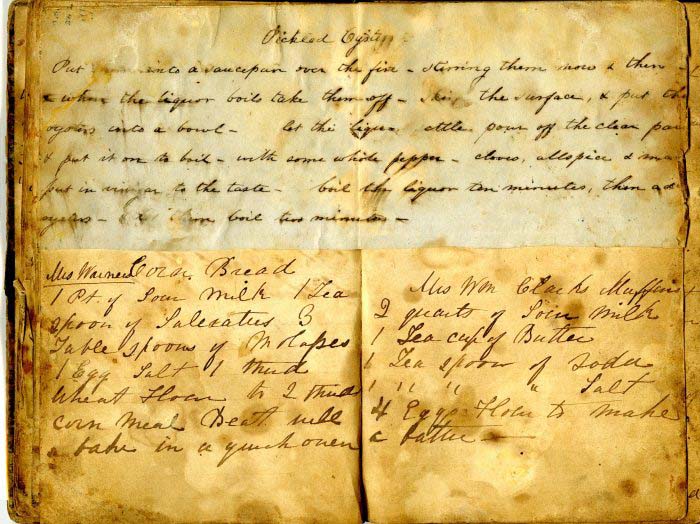History of Food and Drink Collection is explored one blog post at a time

A recently acquired book of recipes at Virginia Tech’s Special Collections is a bit of a mystery.
Archivist Kira Dietz knows that it dates from the late 19th or early 20th century, and the book is well-worn and handwritten. There’s no index. The recipes, or receipts as they’re commonly called, are in no discernible order — instructions for making tallow candles are next to cough syrup and apple pudding. Many of the recipes involve pickling or preserving, which, Dietz says, shows us that this was a common practice for this particular cook.
Dietz used the book as the subject of a recent blog post at What’s Cookin' at Special Collections, a blog she started in September 2011 that features unique and unusual items from the History of Food and Drink Collection at the University Libraries.
The History of Food and Drink Collection has more than 3,500 items related to food history in Special Collections, and new items are added regularly. The collection consists of cookbooks, handwritten and compiled recipe collections, and papers of individuals working in food and nutrition, as well as food-related advertising and promotional materials. Many items are rare and unique, and may only be in a handful of other libraries in the United States.
The Virginia Tech Libraries began collecting items related to culinary history with the donation of 750 cookbooks from the estates of Dora Greenlaw Peacock and Laura Jane Harper. Harper was a professor in the College of Home Economics and was the first woman to serve as an academic dean at Virginia Tech, and Peacock was a teacher and wife of Markham Peacock, an English professor. In 2005, Ann Hertzler, professor emeritus in human nutrition, foods and exercise, endowed the Ann Hertzler Children's Cookbook and Nutrition Literature Collection, which comprises nearly 400 titles
“Each person grows up in their own food culture,” Dietz said. Everyone has to eat, and that is one thing that people have in common. What is available to eat, and how people prepare their food, however, varies greatly depending upon a number of factors. “In building this collection, we can learn about similarities common across many cultures, differences that may appear regionally, and how food trends have changed over time,” Dietz said.
Many items tell a deeper story. The 1914 book, The American Colored Waiter, was written by John B. Goins, an African-American waiter in Chicago. In his book, Goins detailed best practices with regards to dress codes, carving, setting a banquet, and tipping (a practice of which Goins did not approve). The book gives modern readers a glimpse at not just the foodways of a century ago, but also working conditions, class, and race relations.
Some items in the collection are just a fun look at menus past. Dietz seems especially intrigued by gelatin recipes from the mid-20th century.
"The obvious benefit to gelatinous canapes?" she writes in a post about a promotional pamphlet from Knox Gelatin. "No crumbs on the carpet if your guests are wandering and mingling while they’re eating. The eggs and other potential fillings are trapped inside."
But even the gooey lens of Jell-O gives us insight as to how American culture changed after World War II. Dietz writes, "Publications like this one offer a wonderful, colorful, sometimes-wobbly picture of entertaining in the modern era — the distinctive colors, shapes of molds, and creative twists on contemporary foods. The television-demonstration nature of Knox On-Camera Recipes hints at the advertising history of the period, while appealing to our desire to be part of the entertainment experience."




